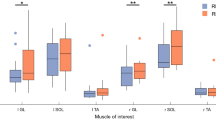Abstract
We evaluated the effectiveness of vibrotactile feedback to enhance protective stepping with a view to developing a prosthesis for patients with balance disorders. Subjects standing on a moving walkway were exposed to an unpredictable, abrupt backwards translation of the support surface that required a step response to remain standing. The subjects were 15 normal young, 15 normal elderly and 9 patients with either bilateral vestibular loss or peripheral neuropathy. The initial passive displacement of the body was recorded by a gyroscope placed on the leg which triggered a vibration pulse to the trigeminal distribution on the forehead to cue a forwards step. Stepping responses and postural sway, with and without vibration feedback, were compared. Vibration produced significantly shorter stepping reaction times only in the elderly normals with naturally slower stepping. Patients did not benefit in any way. We conclude that the effectiveness of vibration biofeedback appears limited. Any enhancement of compensatory stepping might be triggered by speeding the decision to step rather than by creating a specific stimulus-response loop.
Similar content being viewed by others
References
Aminian K, Najafi B, Bula C, Leyvraz PF, Robert P (2002) Spatio-temporal parameters of gait measured by an ambulatory system using miniature gyroscopes. J Biomech 35:689–699
Asseman F, Bronstein AM, Gresty MA (2005) Feasibility of vibro-tactile biofeedback to cue balance in patients with vestibular loss. In: 5th meeting of the British Society of Neuro-Otology. London
Asseman F, Bronstein AM, Gresty MA (2006) Vibro-tactile feedback cueing a step response to balance challenge. In: Proc Physiol Soc 1.University College London, pPC12
Bergin PS, Bronstein AM, Murray NM, Sancovic S, Zeppenfeld DK (1995) Body sway and vibration perception thresholds in normal aging and in patients with polyneuropathy. J Neurol Neurosurg Psychiatry 58:335–340
Bockisch CJCA, Straumann D, Hess K, Haslwanter T (2004) Enhanced smooth pursuit eye movements in patients with bilateral vestibular deficits. Neuroreport 15:2617–2620
Campbell AJ, Reinken J, Allan BC, Martinez GS (1981) Falls in old age: a study of frequency and related clinical factors. Age Ageing 10:264–270
Dozza M, Chiari L, Horak FB (2005) Audio-biofeedback improves balance in patients with bilateral vestibular loss. Arch Phys Med Rehabil 86: 1401–1403
Guerraz M, Yardley L, Bertholon P, Pollak L, Rudge P, Gresty MA, Bronstein AM (2001) Visual vertigo: symptom assessment, spatial orientation and postural control. Brain 124:1646–1656
Hale S, Myerson J, Wagstaff D (1987) General slowing of nonverbal information processing: evidence for a power law. J Gerontol 42:131–136
Inglis JT, Horak FB, Shupert CL, Jones-Rycewicz C (1994) The importance of somatosensory information in triggering and scaling automatic postural responses in humans. Exp Brain Res 101:159–164
Lord SR, Castell S (1994) Physical activity program for older persons: effect on balance, strength, neuromuscular control, and reaction time. Arch Phys Med Rehabil 75:648–652
Luchies CW, Alexander NB, Schultz AB, Ashton-Miller J (1994) Stepping responses of young and old adults to postural disturbances: kinematics. J Am Geriatr Soc 42:506–512
Luchies CW, Wallace D, Pazdur R, Young S, De Young AJ (1999) Effects of age on balance assessment using voluntary and involuntary step tasks. J Gerontol A Biol Sci Med Sci 54:M140–M144
Maki BE, McIlroy WE, Fernie GR (2003) Change-in-support reactions for balance recovery. IEEE Eng Med Biol Mag 22:20–26
Martin JP (1967) The Basal Ganglia and Posture. Pitman Medical and JB, Lippincott Co, London
Perry SD, McIlroy WE, Maki BE (2000) The role of plantar cutaneous mechanoreceptors in the control of compensatory stepping reactions evoked by unpredictable, multi-directional perturbation. Brain Res 877:401–406
Peterka RJ, Black FO (1990) Agerelated changes in human posture control: sensory organization tests. J Vestib Res 1:73–85
Rogers MW, Hedman LD, Johnson ME, Martinez KM, Mille M-L (2003) Triggering of protective stepping for the control of human balance: age and contextual dependence. Cognitive Brain Research 16:192–198
Rogers MW, Kukulka CG, Brunt D, Cain TD, Hanke TA (2001) The influence of stimulus cue on the initiation of stepping in young and older adults. Archives of Physical Medicine and Rehabilitation 82:619–624
Tong K, Granat MH (1999) A practical gait analysis system using gyroscopes. Med Eng Phys 21:87–94
Tyler M, Danilov Y, Bach YRP (2003) Closing an open-loop control system: vestibular substitution through the tongue. J Integr Neurosci 2:159–164
Wall C 3rd, Kentala E (2005) Control of sway using vibrotactile feedback of body tilt in patients with moderate and severe postural control deficits. J Vestib Res 15:313–325
Wall C 3rd,Weinberg MS, Schmidt PB, Krebs DE (2001) Balance prosthesis based on micromechanical sensors using vibrotactile feedback of tilt. IEEE Trans Biomed Eng 48:1153–1161
Woollacott MH, Shumway-Cook A, Nashner LM (1986) Aging and posture control: changes in sensory organization and muscular coordination. Int J Aging Hum Dev 23:97–114
Author information
Authors and Affiliations
Corresponding author
Rights and permissions
About this article
Cite this article
Asseman, F., Bronstein, A.M. & Gresty, M.A. Using vibrotactile feedback of instability to trigger a forward compensatory stepping response. J Neurol 254, 1555–1561 (2007). https://doi.org/10.1007/s00415-007-0587-7
Received:
Revised:
Accepted:
Published:
Issue Date:
DOI: https://doi.org/10.1007/s00415-007-0587-7




